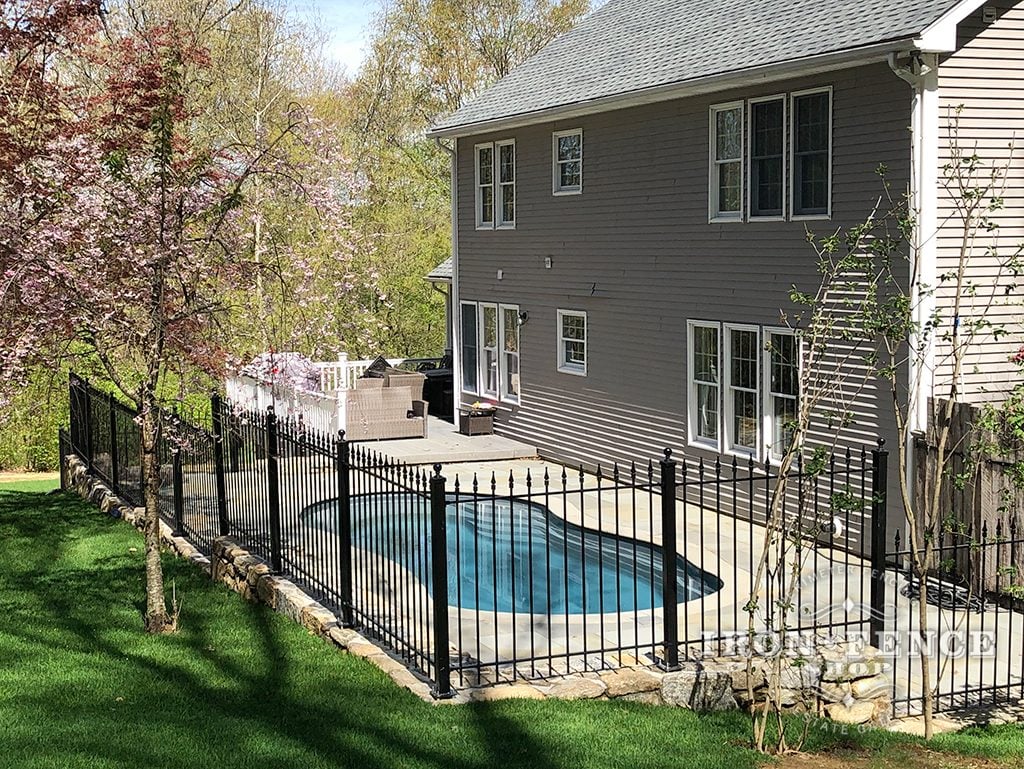
Iron fences provide security, durability, and a classic aesthetic to any property. If you need to mount an iron fence on top of a concrete slab or wall rather than embedding fence posts into the ground, using surface mount flange posts is an excellent option.
However, proper installation requires careful consideration of the surface type, hardware, and spacing. In this guide, we will walk you through everything you need to know about installing an iron fence on concrete or wall surfaces.
Check out our video that covers using these flange posts with your iron fence.
Understanding Surface Mount Flange Posts
Surface mount flange posts are designed for situations where traditional in-ground fence posts cannot be used. Instead of being buried in concrete, flange posts are bolted directly onto a concrete slab or solid wall.
This method is ideal for patios, breezeways, pool decks, sidewalks, and driveways. However, the surface must be in good condition and meet thickness requirements for a secure installation.
Mounting Flange Posts on a Walking Surface
When installing flange posts on a walking surface, it is essential to consider the material and thickness of the surface. Not all surfaces are suitable for flange post-installation, and using the wrong type of surface can lead to instability.
Ideal Surfaces
Flange posts work best when mounted on a solid concrete slab that is at least 4 inches thick and in good condition (free from major cracks or spalling).
Surfaces to Avoid
Certain walking surfaces do not provide the stability needed for flange post installation. These include:
- Asphalt or blacktop – Too soft to hold anchor bolts; metal fence posts should be set into concrete instead.
- Paver stones or individual stone slabs – Can shift over time, causing fence posts to loosen.
- Wood decks – Deck boards are too thin to hold the fence post securely unless additional reinforcements are installed.
If your surface does not meet the required criteria, consider alternative installation methods, such as embedding the fence posts in concrete.
Mounting Flange Posts on a Wall or Curb
Installing an iron fence on top of a wall or curb requires additional planning due to the variations in wall construction materials and widths. Ensuring a solid and stable mounting surface is crucial for a secure installation.
Key Considerations
Mounting on a wall or curb is more complex due to variations in materials and construction. General guidelines include:
- Solid construction – The top of the wall should be solid, without loose bricks or mortar joints.
- Wall cap thickness – If capped, it should be at least 3-4 inches thick and securely affixed.
- Wall width – A minimum of 10-12 inches is recommended to accommodate the flange post base and avoid cracking.
Edge Distance for Anchors
To prevent cracking, follow these anchor placement guidelines:
- 4 inches from the wall edge to the middle of the anchor
- 1 and 7/8 inches from the wall edge to the anchor hole (for 3/8-inch anchors)
- Always refer to the anchor manufacturer’s instructions for precise measurements.
Spacing and Placement Considerations
Proper spacing and placement of flange posts play a crucial role in ensuring a stable and visually appealing fence. Consider how much space the flange posts will take up and how their placement affects the overall fence alignment.
Edge Distance Impact
When placing flange posts on a slab, you must account for the required edge distance for anchors, which affects the fence line position. Placing fence posts too close to the slab’s edge increases the risk of cracking, while moving them inward reduces usable space. Plan ahead to balance security and aesthetics.
Recommended Anchor Bolts and Tools
Using the right concrete anchor bolts and tools is essential for securing flange posts properly. Different surfaces require different anchor types to ensure a firm hold.
Essential Tools
To install flange posts into concrete, you will need:
- Hammer drill (with masonry drill bits)
- Impact driver or wrench
- Tape measure and level
- Concrete anchors
Types of Concrete Anchors
Two commonly used concrete anchors are:
1. Concrete wedge anchors (Thunderstuds/Redhead anchors)
- Best for solid concrete surfaces
- Expand in the hole when tightened for a strong hold
- Avoid drilling through the entire surface, as this weakens the hold
2. Tapcon-style concrete screws
- Ideal for porous materials like brick or stone
- Large threads grip into the drilled hole for a firm hold
Both types require pre-drilled holes to the recommended depth.
Alternatives to Flange Posts
If flange posts are not suitable due to surface type or space constraints, consider these alternatives:
Traditional In-Ground Posts
If there is grass or soil around the slab, fence posts can be buried 2-3 feet deep in concrete for maximum stability.
Core Drilling
- Uses a specialty tool on concrete or stone that requires drilling, allowing the post to be concreted in place.
- Provides a cleaner appearance without flanges or exposed anchors.
- Requires professional equipment and expertise.
Installing Fence on Concrete Slab
Before installing your iron fence, ensure your mounting surface meets the necessary thickness and condition requirements. Position flange posts far enough from the slab edge to prevent cracking while preserving usable space. Select the right anchor hardware for your specific surface type. If uncertain, consult with a professional or the iron fence supplier for guidance.
By carefully planning your installation and following these best practices, you can securely mount your iron fence project onto a concrete slab or wall, ensuring durability and stability for years to come.
 Free Shipping over $5,000
Free Shipping over $5,000
 15 Years in Business
15 Years in Business
 18mo No Interest Financing
18mo No Interest Financing


